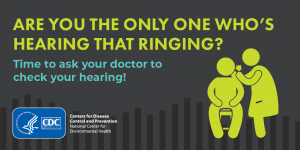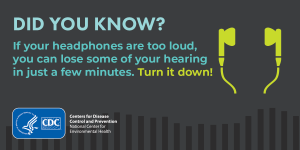October is “National Protect Your Hearing Month.”
Posted on by
Did you know that …?
Repeated exposure to loud noise over the years can damage your hearing—long after exposure has stopped.
This is just one of the many informative facts available on CDC’s National Center for Environmental Health’s hearing loss website: https://www.cdc.gov/nceh/hearing_loss/default.html.
Think you’re aware of how to protect yourself? When it comes to hearing loss, we can all think of the usual suspects: attending sporting events, loud concerts, and fireworks.
The outer ear—the part of the ear you see—funnels sound waves into the ear canal.
However, you may be surprised at what you don’t know. For example, everyday activities such as using power tools, mowing the lawn, or attending a gym or fitness class with loud music can also damage hearing.
The site features detailed information on the following topics: “What Noises Cause Hearing Loss?” “How Does Loud Noise Cause Hearing Loss?” “How Do I Know if I Have Hearing Loss Caused by Loud Noise?” “How Do I Prevent Hearing Loss from Loud Noise?” and “What If I Already Have Hearing Loss?”
Browse the pages to discover critical information you’re likely unaware of.

Useful Info
Is the noise too loud? If you need to shout to make yourself heard, yes.
After a very loud event, such as a concert or football game, normal hearing usually returns within a few hours to a few days—however, repeated exposure to loud noises will eventually damage the inner ear permanently.
Ways to protect your hearing include avoiding loud noise, using hearing protection such as earplugs or noise-cancelling earmuffs when you can’t, turning the volume down on personal listening devices, and taking periodic breaks from loud noise.
Signs that you may have hearing loss include difficulty hearing high-pitched sounds (e.g., doorbell, telephone, alarm clock), difficulty understanding conversations in a noisy place, pain, discomfort, or ringing in your ears. If you are experiencing any of these symptoms, consult with your physician.

By the Numbers
“Sound is measured in decibels (dB). A whisper is about 30 dB, normal conversation is about 60 dB, and a motorcycle engine is about 95 dB.”
In 1999, the World Health Organization Guidelines for Community Noise concluded that a 24-hour equivalent sound level of 70 dB or below would avoid hearing impairment in 95% of people, even over a lifetime exposure.
Hearing loss is the third most common chronic health condition in the United States. Almost twice as many people report hearing loss as report diabetes or cancer. In the United States, about 40 million adults aged 20–69 years have noise-induced hearing loss, and about 1 in 4 adults who report “excellent to good” hearing already have hearing damage.
By the time you notice hearing loss, many hair cells have been destroyed and cannot be repaired.
Think that hearing damage is usually workplace-related? Activities away from work can damage hearing just as much a noisy job. Over half of all adults with hearing damage do not have noisy jobs.
“By the time you notice hearing loss, many hair cells have been destroyed and cannot be repaired.”
The average person is born with about 16,000 hair cells within their inner ear. These cells allow your brain to detect sounds. By the time changes in your hearing can be measured by a hearing test, up to 30% to 50% of hair cells can be damaged or destroyed.
There is no treatment for hearing loss! Damaged inner ear cells do not grow back. Protect your hearing, and if you already have hearing loss, take steps to keep it from getting worse.
More Information
- Loud Noise Can Cause Hearing Loss
- Roll, Pull, and Hold. How to Wear Soft Foam Earplugs – Animated video
- Roll, Pull, and Holdimage icon – Animated GIF
- NIH’s Noisy Planet
- NIDCD
Tweet this: “October is National Protect Your Hearing Month. Learn simple steps you can take to protect your hearing from loud noise. https://bit.ly/3j1VzlK #NPYHM #CDCEHblog via @CDCEnvironment”


Post a Comment